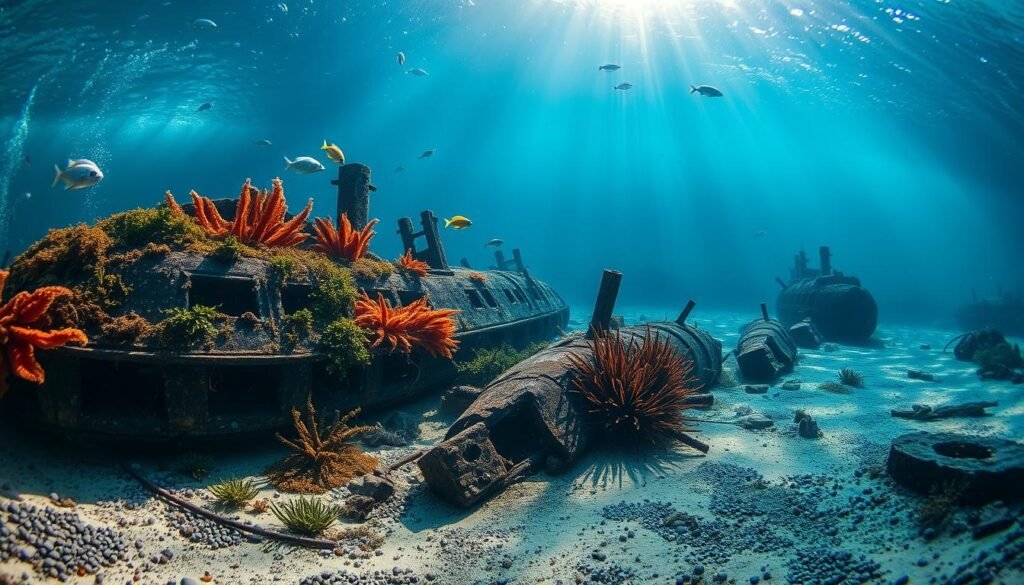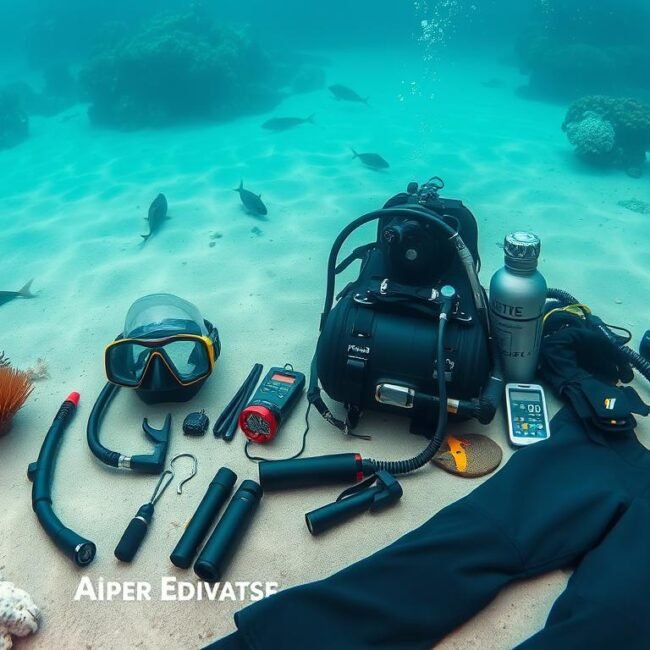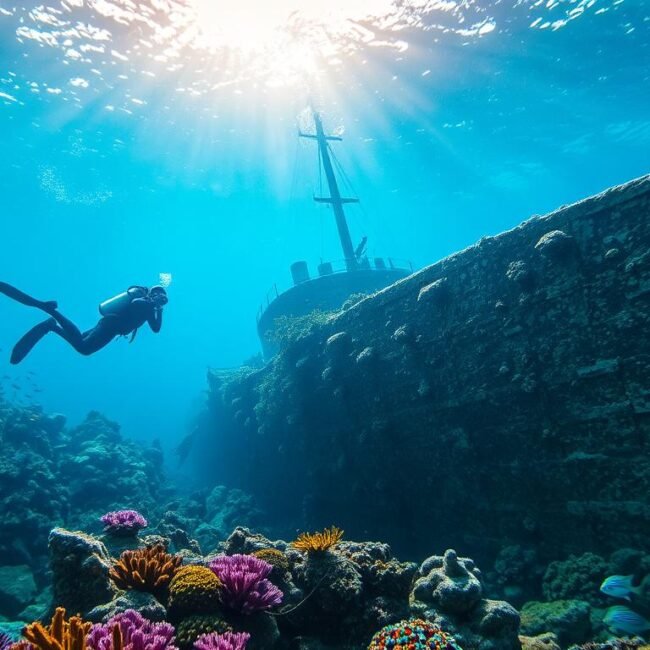I’m excited to share my knowledge of the Great Lakes shipwrecks. This is a treasure trove for wreck diving enthusiasts. The Great Lakes region is filled with shipwrecks, making it a top spot for scuba diving.
Exploring the Great Lakes shipwrecks is amazing. From Lake Michigan to Lake Huron, each lake has its own story. Wreck diving here is an adventure, with clear waters and historic wrecks to discover.
For scuba diving fans, the Great Lakes offer many chances to find new wrecks. With the right gear and knowledge, divers can explore the region’s history. It’s a unique experience.
Key Takeaways
- The Great Lakes region is home to numerous shipwrecks, making it a popular destination for wreck diving.
- Scuba diving in the Great Lakes offers a unique experience, with its rich history and diverse diving conditions.
- The Great Lakes shipwrecks are a treasure trove for wreck diving enthusiasts, with many wrecks preserved for centuries.
- Wreck diving in the Great Lakes requires the right equipment and knowledge to navigate the diverse diving conditions.
- The Great Lakes region offers a wealth of opportunities for scuba diving, with its crystal-clear waters and historic shipwrecks waiting to be explored.
Understanding Wreck Diving in the Great Lakes
Exploring the Great Lakes diving scene, I’m amazed by the area’s rich history. Many shipwrecks from the 19th century lie beneath the surface. The cold water and limited light make it perfect for preserving these wrecks, offering a thrilling dive for all.
The history of Great Lakes shipwrecks draws many divers. The lakes played a key role in the U.S. development, from fur trade to shipping. Learning about these wrecks, I’m captivated by the tales of those who sailed them.
The Historical Significance of Great Lakes Shipwrecks
The Great Lakes have been crucial to the U.S. economy since early exploration. The wrecks on the lake beds remind us of this importance. Exploring these sites, I realize each wreck has its own story, waiting to be discovered.
Why These Waters Are Perfect for Wreck Preservation
The cold water and limited sunlight in the Great Lakes are ideal for preserving wrecks. The slow decay process means divers can see well-preserved ships. This makes diving here a top choice for those interested in shipwreck history and preservation.
Best Times of Year for Great Lakes Diving
The best diving times in the Great Lakes are spring and summer. The warmer water and clearer visibility are perfect for exploring. But, the weather can change quickly, so divers must be ready for anything. With proper training and gear, diving here is both rewarding and exciting.
The Arabia: Lake Huron’s Hidden Treasure
Exploring Great Lakes treasure, I’m drawn to the Arabia shipwreck in Lake Huron. This wreck is famous for its well-preserved cargo and interesting history. It’s a top spot for anyone into Lake Huron diving.
The Arabia shipwreck is a treasure hunter’s dream. Its cargo holds are still full of artifacts from the past. For those into Great Lakes treasure, this site is a treasure trove. It gives a peek into the area’s rich maritime history. Some key highlights include:
- Well-preserved cargo holds filled with artifacts
- Intriguing history and stories of the ship’s sinking
- Opportunities for treasure hunting and exploration
Exploring the Arabia shipwreck reminds me of the need to save our maritime history. The Great Lakes have many shipwrecks, each with its own story. For those diving in Lake Huron, the Arabia is a must-see. It offers a look into the region’s history and treasure.
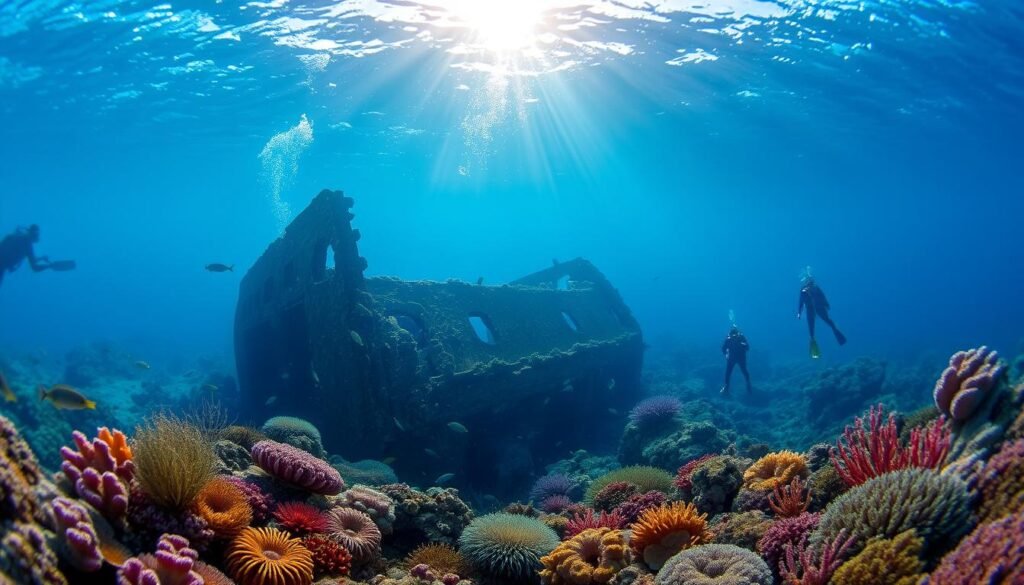
The Arabia shipwreck is a testament to the region’s rich maritime history, and its preservation is crucial for future generations to learn from and appreciate.
Essential Equipment for Great Lakes Wreck Diving
Before diving into the Great Lakes, I always check my scuba gear. The Great Lakes need special equipment because of their cold water and limited visibility. This gear must be able to handle these conditions.
For cold water diving, a good wetsuit or dry suit is key. I also carry a reliable regulator, BCD, and tank. Safety items like a dive light and signaling device are vital in emergencies. Here’s what you should have in your safety kit:
- Dive light
- Signaling device
- First aid kit
- Emergency oxygen supply
Along with safety gear, I also think about cameras and lights. A good underwater camera and lighting can help capture the beauty of the wrecks. This is important for seeing the stunning scenery and marine life of the Great Lakes.
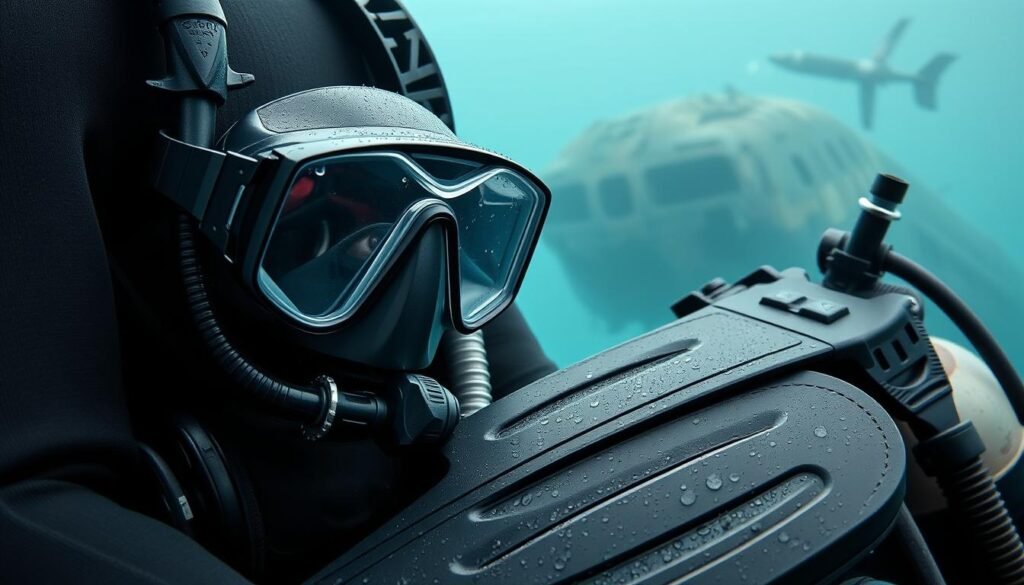
With the right scuba gear, including cold water and safety equipment, I can dive safely and enjoyably in the Great Lakes.
| Equipment | Description |
|---|---|
| Wetsuit or dry suit | Insulation and protection from cold water |
| Regulator | Delivers air to the diver |
| BCD | Provides buoyancy control |
| Tank | Stores air for the diver |
The SS Edmund Fitzgerald: Lake Superior’s Famous Wreck
Exploring Great Lakes shipwrecks, the SS Edmund Fitzgerald is a standout. Located in Lake Superior, it has a rich history and a tragic sinking. For those into Lake Superior diving, it’s a key site, offering a peek into the maritime past.
The SS Edmund Fitzgerald was a huge freighter that sank in a storm on Lake Superior in 1975. This loss of all 29 crew members has made it a famous wreck. Diving here is unique, with its well-preserved wreckage and eerie feel.
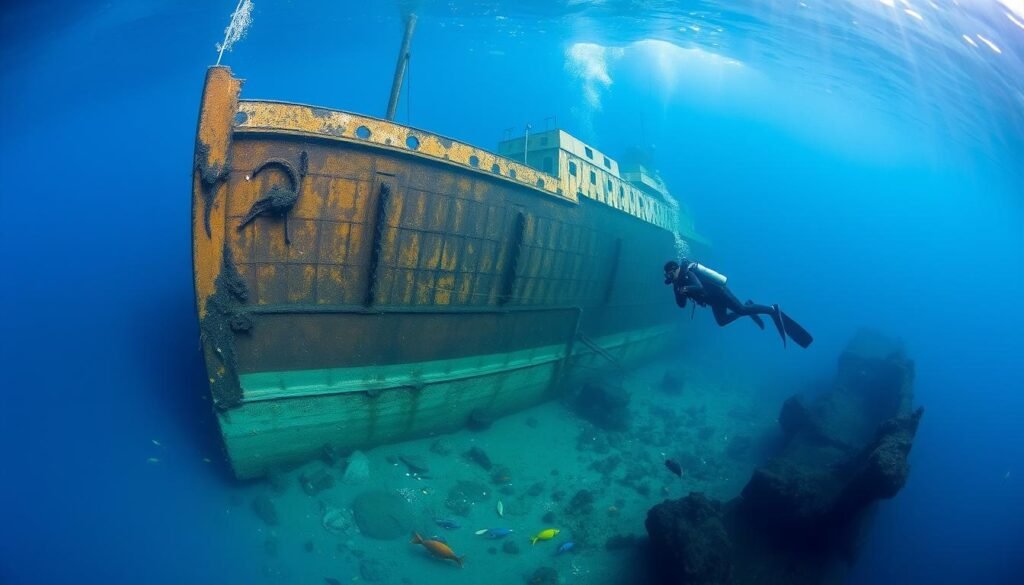
Exploring the SS Edmund Fitzgerald comes with challenges and rewards. The wreck is at about 530 feet deep, requiring specialized training and gear. Yet, diving this historic ship is unmatched, with its massive propeller and cargo holds still there. It’s a must-see for anyone into Great Lakes shipwrecks and Lake Superior diving.
- Location: Lake Superior
- Depth: 530 feet
- Type: Technical dive
- Recommended for: Experienced divers
In conclusion, the SS Edmund Fitzgerald is a legendary Great Lakes shipwreck. It offers a unique diving experience with its rich history and well-preserved wreckage. It’s a must-visit for anyone into Lake Superior diving and maritime history.
Diving Certifications and Requirements
As I get ready for my wreck diving adventure in the Great Lakes, I know how key diving certifications are. They ensure a safe and successful dive. For more complex wreck dives, technical diving certifications are often needed.
Before starting, I need to look into the local diving rules and permits. This includes knowing the rules from the U.S. Coast Guard and the National Park Service. By knowing these regulations, I can make sure my dive is smooth and fun.
Technical Diving Certifications Needed
Technical diving certifications, like those from PADI or TDI, teach divers important skills. They learn about decompression, gas management, and emergency plans. These skills are vital for complex wreck dives.
Local Regulations and Permits
Local rules and permits change based on where you dive and the dive type. Some wrecks might be in national parks, while others need special permits. Knowing these rules helps me plan my dive right and avoid problems.
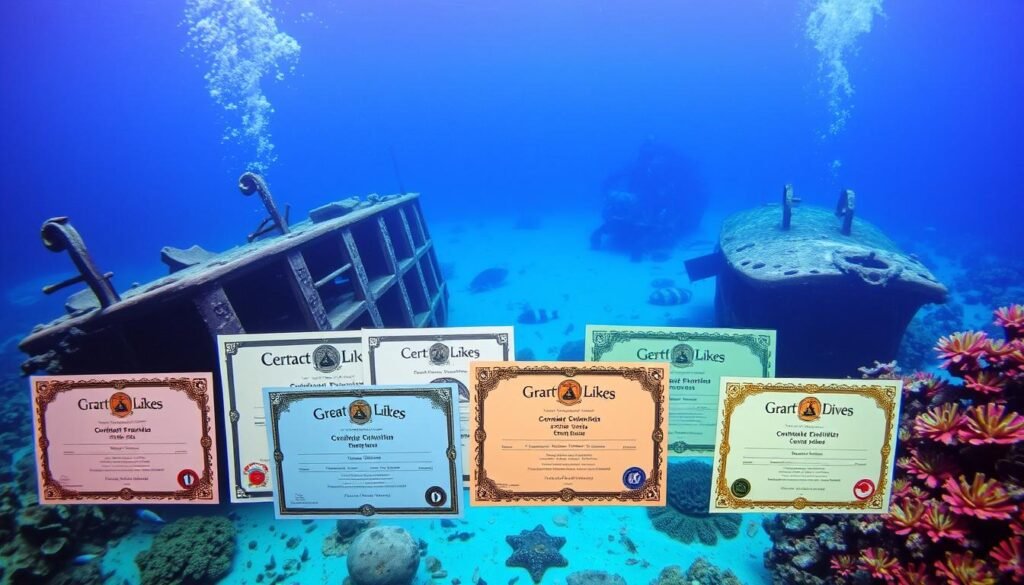
Finding Qualified Dive Operators
Finding a qualified dive operator is crucial for a safe dive. They should know the local rules and conditions well. By choosing a reputable operator, I can be sure my dive is well-planned. I’ll also get the help and support I need during the dive.
The SS Cedarville: A Maritime Marvel in the Straits of Mackinac
Exploring Great Lakes shipwrecks, I’m drawn to the SS Cedarville. This historic ship sank in the Straits of Mackinac. It’s a key part of the region’s maritime history, with its unique design and story.
For those who dive in the Straits of Mackinac, the SS Cedarville is a must-see. It offers a peek into the past and a chance to see the wreckage up close.
The SS Cedarville’s history is captivating. Built in the late 19th century, it was a major player in the Great Lakes shipping world. Its sinking in the Straits of Mackinac was a tragic event that claimed several lives.
Today, the wreckage reminds us of the importance of preserving our maritime heritage. It also highlights the need for safe and responsible diving practices.
For those eager to dive in the Straits of Mackinac, the SS Cedarville is perfect. It’s a chance to explore a well-preserved shipwreck. The site has intact cargo holds and a majestic structure.
As a Great Lakes shipwrecks enthusiast, I can say the SS Cedarville is amazing. Its rich history and stunning architecture make it a must-see for diving and maritime history fans.
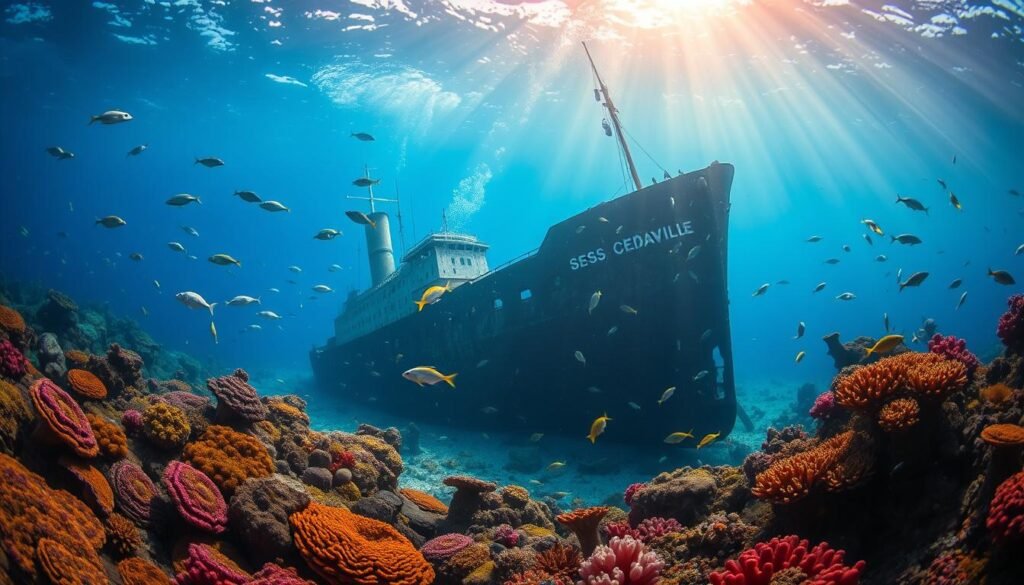
- Length: 291 feet
- Beam: 41 feet
- Depth: 30-40 feet
- Location: Straits of Mackinac, near Mackinac Island
These details make the SS Cedarville a great spot for divers. It’s perfect for both beginners and experienced explorers. Whether you dive in the Straits of Mackinac or just want to learn about Great Lakes shipwrecks, the SS Cedarville is fascinating.
Weather Patterns and Diving Conditions
The Great Lakes region has unpredictable weather, which can change diving conditions. It’s key for divers to know about the weather and how it affects the water. The weather can change quickly, making the water temperature and visibility unpredictable.
To plan a safe and successful dive, consider these factors:
- Water temperature: The Great Lakes’ water temperature changes a lot throughout the year. It can be around 40°F (4°C) in winter and up to 70°F (21°C) in summer.
- Visibility: Visibility in the Great Lakes can vary. It can be a few feet or over 100 feet, depending on where you are and the time of year.
- Wind conditions: Strong winds can make the sea rough. This can make diving hard.
Knowing the weather patterns and diving conditions is key for a great dive. By planning with these factors in mind, you can have a safe and fun dive. You’ll get to see the Great Lakes’ shipwrecks and underwater wonders.
| Month | Water Temperature (°F) | Visibility (feet) |
|---|---|---|
| January | 40 | 10 |
| July | 70 | 50 |
| October | 50 | 20 |
The SS Daniel J. Morrell: Lake Huron’s Split Wreck
The SS Daniel J. Morrell is in Lake Huron. It’s a tough wreck dive with a split hull. As an experienced diver, I know Lake Huron diving is unique and rewarding. The SS Daniel J. Morrell shows this with its detailed layout and tough dive conditions.
To dive the SS Daniel J. Morrell, divers need advanced dive planning. They must plan the dive route, watch the weather, and use special gear. This ensures a safe and fun dive.
- Strong currents and limited visibility
- Complex navigation through the wreck’s split hull
- Specialized equipment, such as rebreathers and dive computers
By tackling these challenges with advanced dive planning, divers can explore the SS Daniel J. Morrell. They’ll get to enjoy the best of Lake Huron diving.
The USS Chicora: Lake Michigan’s Mystery
Exploring Great Lakes shipwrecks, I’m captivated by the USS Chicora in Lake Michigan. This ship has a fascinating history and architecture. For those into Lake Michigan diving, it’s a key site to explore.
The USS Chicora is remarkable for its preservation. It’s a prime example of wreck preservation in the region. This makes it perfect for both divers and history buffs. Let’s dive into its history and current state.
Historical Background
The USS Chicora was a Union gunboat in the American Civil War. It’s known for its bravery and sacrifice. Its role in Lake Michigan’s history makes it a favorite among divers and shipwreck enthusiasts.
Current State of the Wreck
Now, the USS Chicora rests at the bottom of Lake Michigan. It’s a reminder of the area’s rich maritime history. Divers find it a treasure trove of history and architecture.
Diving the USS Chicora comes with its own set of challenges and rewards. Understanding its historical importance makes the dive even more special. It’s a memorable experience in Lake Michigan diving.
| Shipwreck | Location | Depth |
|---|---|---|
| USS Chicora | Lake Michigan | 80-100 feet |
Conclusion: Embracing the Adventure of Great Lakes Wreck Diving
The Great Lakes offer a unique and thrilling diving experience. The sunken vessels here have a rich history. They are well-preserved, making them a treasure for scuba divers.
Whether you’re experienced or new to diving, the Great Lakes have something for everyone. You’ll face challenges and learn new skills. It’s a chance to discover the region’s history and grow as a diver.
When planning your dive, always put safety first. Make sure you have the right certifications. Work with experienced dive operators to explore these underwater worlds safely. With the right mindset and preparation, you’ll make memories that last a lifetime.

